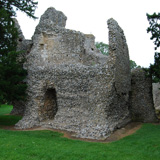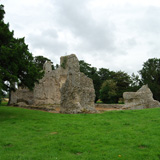History
Weeting Castle was built in approximately 1180 by Hugh de Plais. Hugh was a tenant of William de Warenne, the Earl of Surrey. The Earl resided in nearby Castle Acre, presumably inspiring Hugh to construct Weeting Castle.

While architectural styles were very similar, Castle Acre was a traditional castle. In contrast, Weeting Castle is a rare surviving example of a 12th century residential manor house or East Anglian great house.
Weeting Castle had a hall, chamber area, garderobe, and free-standing service area. The three-story chamber block and garderobe served as the private residence for the de Plais family. The hall, which included a vaulted timber ceiling, was used to entertain guests. Conversely, distinguished visitors were isolated from the service area where food was prepared and stored.
During the mid-13th century, a water-filled moat was added to convey a symbol of wealth and prosperity rather than defensive purposes. More than a century later, in the late 14th century, ownership of the castle passed by marriage to the Howard family. While they grew in prominence to the title of Duke of Norfolk, Weeting Castle was ultimately abandoned around 1390. Thereafter, it fell into a state of disrepair. During the 18th century, a domed ice house was built on the grounds to store the ice collected from the frozen moat in winter.
Castle Highlights
Today, only stone ruins and a dry moat constitute the primary remnants of Weeting Castle. However, ample flint stonework of the chamber remains intact to convey the structure of the original arched doorways and windows.
The most important room was the rectangular hall. It would have had an open floor plan up to its timber roof. At the end of the hall was the three-story chamber block, with a vaulted ground floor for storage and a suite of private chambers with a mural fireplace on the first floor.
The castle generally possesses a coarse appearance, probably due to the removal of its smooth ashlar dressing stone from the outermost walls. It was most likely removed for use on other buildings in the village.
Locating the castle may be challenging due to poor signage on B1106. Although Weeting is a small village, knowing Weeting Castle is situated in a field near the church of Weeting St. Marys is beneficial. Since the castle exists far enough from the town, its location provides a tranquil area to relax in a serene environment. A brief visit is recommended if touring other sites in Norfolk. As Castle Acre and Castle Rising Castle reside near Weeting Castle, it is possible to visit all of them on the same day.
Weeting Castle is also haunted.


